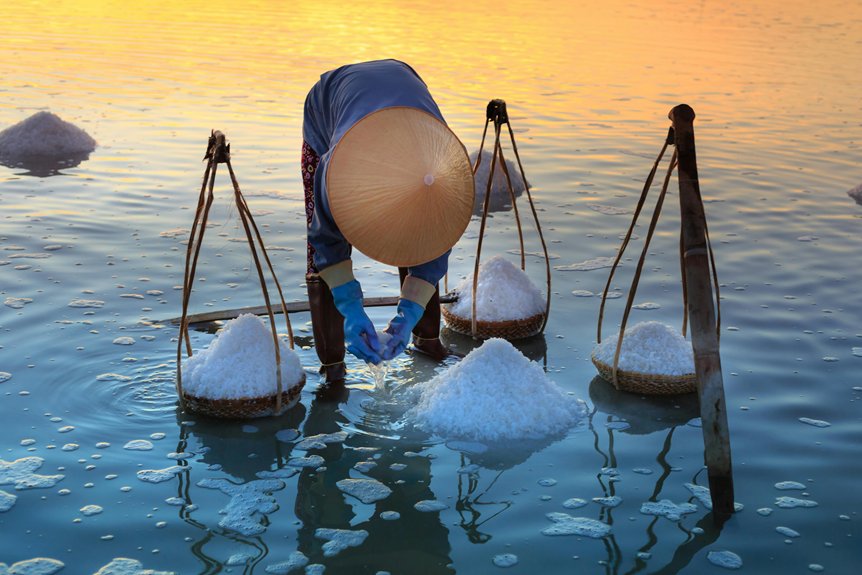Capture breathtaking flamingo photographs at Larnaca Salt Lake during winter months. You’ll need a telephoto lens (200-400mm), sturdy tripod, and early morning positioning. Arrive before dawn to catch golden light illuminating thousands of pink flamingos against reflective waters. Stay on designated trails, move slowly, and respect the delicate ecosystem. Your patience will reward you with stunning wildlife images that reveal the lake’s natural magic. More secrets await your exploration.
Key Takeaways
- Aliki Lake in Larnaca Salt Lake provides an exceptional winter habitat for thousands of flamingos from November through March, offering prime sunrise photography opportunities.
- Strategic preparation requires arriving before dawn with essential gear: wide-angle and telephoto lenses, sturdy tripod, multiple batteries, and appropriate cold-weather clothing.
- Optimal photography techniques include using telephoto lenses (200-400mm), employing burst mode, and capturing the distinctive pink plumage during early morning golden light.
- Responsible wildlife photography demands staying on designated trails, maintaining significant distance from flamingos, and respecting the sensitive Ramsar Wetlands ecosystem.
- The salt lake’s unique ecological balance, supported by dark red algae and small shrimp, creates a remarkable backdrop for capturing flamingos in their natural wintering environment.
Where and When to Find Flamingos in Larnaca
The stunning Larnaca Salt Lake offers wildlife photographers and nature enthusiasts an exceptional opportunity to observe Greater Flamingos in their natural winter habitat. Aliki Lake, a key component of the salt lake complex, serves as the primary viewing location for sunrise flamingo photography in Cyprus. From November through March, thousands of flamingos congregate here, creating a remarkable spectacle for patient observers.
Strategic positioning requires arriving before dawn to capture ideal lighting conditions. Position yourself along designated trails, ensuring minimal disturbance to the sensitive ecosystem. Your camera settings should anticipate low-light environments, with high ISO and wide aperture capabilities. Telephoto lenses facilitate detailed captures without approaching the birds’ habitat.
The lake’s abundant brine shrimp population attracts not just flamingos but over 85 migratory bird species, expanding potential photographic opportunities. Prioritize respect for the environment by remaining on marked pathways and maintaining a quiet, observant approach to document these elegant creatures.
Essential Photography Gear for Salt Lake Sunrise Shoots
When preparing for a flamingo photography session at Larnaca Salt Lake, your gear selection can make or break the shooting experience. Opt for a wide-angle lens to capture the expansive landscape and dramatic sunrise hues, which will provide context and depth to your flamingo images.
For intimate wildlife shots, pack a telephoto lens in the 200-400mm range. This allows you to photograph flamingos without disturbing their natural behavior, maintaining a respectful distance while capturing intricate details. A sturdy tripod becomes essential for long exposure shots and capturing perfect reflections in the lake’s still waters.
Don’t underestimate practical considerations. Bring multiple battery packs and memory cards to guarantee uninterrupted shooting during the critical sunrise hours. Your clothing matters too-dress in layers and wear appropriate footwear to handle the early morning’s chilly conditions, allowing you to focus entirely on capturing stunning flamingo photographs.
Understanding Flamingo Behavior and Habitat
Because Larnaca Salt Lake represents a critical wintering habitat, photographers must understand the intricate ecosystem supporting its flamingo populations. The lake’s delicate balance hinges on dark red algae, which sustains small shrimp-the primary food source for flamingos during their November to March residency.
Capturing the delicate ecosystem of Larnaca Salt Lake requires understanding the intricate balance of algae, shrimp, and flamingo life.
Observing flamingo behavior requires patience and respect for their environment. These birds communicate through distinctive honking sounds, maintaining cohesion within large flocks. Their social structure depends on collective movements and shared feeding strategies.
The ecosystem’s sensitivity demands strict boundaries. Wading into the salt lake can disrupt the flamingos’ habitat, potentially causing long-term ecological damage. As a protected Ramsar Wetlands site and EU Natura 2000 area, the lake represents a critical conservation zone for migratory bird populations.
Your photographic approach should prioritize minimal environmental impact, using telephoto lenses to capture intimate moments without disturbing these magnificent birds in their natural sanctuary.
Best Vantage Points and Photography Techniques
Mastering flamingo photography at Larnaca Salt Lake demands strategic positioning and technical precision. You’ll want to leverage the designated shoreline trails, which offer unobstructed views of the vibrant flock. These carefully planned paths provide ideal vantage points for capturing the birds’ intricate interactions and elegant movements.
Select a telephoto lens of 200mm or more to isolate individual flamingos and reveal their exquisite pink plumage. Your approach matters critically; move slowly and deliberately to prevent disrupting their natural behaviors. Employ burst mode to document dynamic moments-feeding, preening, or social interactions-ensuring you capture split-second gestures that convey the essence of their community.
Early morning light bathes the salt lake in warm, soft tones, creating optimal photographic conditions. By understanding the environment and employing calculated techniques, you’ll transform fleeting moments into compelling visual narratives that celebrate these extraordinary birds.
Local Travel Tips and Access to Larnaca Salt Lake
Traversing the Larnaca Salt Lake necessitates meticulous preparation and deliberate planning for an ideal visitor experience. Proper access requires strategic navigation through multiple entry points, with careful attention to the terrain’s unique characteristics.
Strategic navigation and meticulous preparation are essential for traversing the intricate terrain of Larnaca Salt Lake.
Photography and exploration are optimized by following these local travel recommendations:
- Select sturdy hiking boots with water-resistant properties to manage muddy and uneven trail surfaces near the salt collection plateau
- Utilize the 4km nature trail, accessing points like the historic Kamares Aqueduct for diverse photographic perspectives
- Respect the Ramsar Wetlands site’s ecological sensitivity by maintaining strict adherence to designated pathways
- Position yourself near the surrounding hills with Mazoteos tombs for enhanced landscape and flamingo viewing angles
Precision in movement and equipment readiness guarantees minimal ecosystem disruption while maximizing photographic opportunities. Understanding the landscape’s topographical nuances and environmental constraints transforms a simple visit into a methodical, immersive experience of Cyprus’s remarkable natural heritage.
Preserving the Ecosystem: Responsible Wildlife Photography
Traversing the delicate balance between capturing the ethereal beauty of flamingos and protecting their habitat demands a methodical approach to wildlife photography. Your lens must become an instrument of conservation, not disruption. At Larnaca Salt Lake, every step and frame requires calculated precision.
Stay strictly on designated trails and observation platforms. These boundaries aren’t arbitrary restrictions but critical safeguards for a globally significant ecosystem. Your photographic technique should prioritize minimal disturbance-use telephoto lenses, avoid sudden movements, and maintain significant distance from the flamingos.
Recognize the lake’s ecological significance: it’s a Ramsar Wetlands site, an EU Natura 2000 location, and a Bird Life International Important Bird Area. Your responsibility extends beyond capturing stunning images-you’re a temporary steward of this delicate environment. Each photograph should reflect respect for the thousands of migratory birds that depend on this habitat’s intricate ecological balance.
Frequently Asked Questions
When Can You See Flamingos in Larnaca Salt Lake?
You’ll find flamingos at Larnaca Salt Lake from November through March, when the first rainy weather arrives. During these winter months, tens of thousands of Greater Flamingos congregate in the lake, creating a spectacular pink landscape. They’re drawn by the lake’s abundant food sources and favorable conditions. Remember, you can’t wade into the lake, but you’ll still enjoy remarkable views of these magnificent migratory birds.
What Time of Year Are Flamingos in Cyprus?
You’ll observe Greater Flamingos in Cyprus from November through March, with peak populations during winter months. Their arrival coincides with favorable water levels and abundant brine shrimp populations. They’ll congregate in impressive numbers at Larnaca Salt Lake, sometimes reaching tens of thousands. The lake’s ecological conditions, including dark red algae and shallow waters, create a perfect wintering habitat for these magnificent migratory birds.
Are There Flamingos in Salt Lake?
Can you imagine a landscape painted in living, breathing pink? Yes, Larnaca Salt Lake hosts significant flamingo populations during winter months. You’ll find substantial flocks of Greater Flamingos inhabiting the lake from November through March, attracted by its high salinity and abundant brine shrimp. The lake’s shallow waters and mudflats create ideal feeding and roosting conditions, supporting tens of thousands of these magnificent birds annually.
Are There Flamingos in Cyprus Now?
You’ll find flamingos in Cyprus during their winter migration season, typically from November to March. Currently, their presence depends on the time of year and water conditions at Larnaca Salt Lake. If you’re visiting during the winter months, you’ll likely spot thousands of Greater Flamingos feeding on shrimp-rich waters. Outside this period, the lake may be less populated, so timing is essential for observing these stunning pink birds.
Conclusion
You’ve braved the pre-dawn chill, lugged your gear across the salt-crusted landscape, and now witness nature’s most fabulous pink performance. These flamingos won’t care about your perfectly calibrated exposure settings or meticulously planned composition. They’ll strut, preen, and migrate at their whim-reminding you that in wildlife photography, you’re merely a humble observer, not the director. Embrace the unpredictability, capture the moment, and respect the delicate dance of survival.

Meet Natalie, who has lived on Cyprus for the last 10 years. She loves exploring the beautiful nature of the island, like quiet forests and untouched beaches. Natalie has lots of cool experiences to share. Join her as she talks about her adventures in Cyprus.

